

|
|
Δείτε εδώ τα πιο πρόσφατα μηνύματα από όλες τις περιοχές συζητήσεων, καθώς και όλες τις υπηρεσίες της AcroBase. H εγγραφή σας είναι γρήγορη και εύκολη. |
|
|||||||
|
 |
|
|
Εργαλεία Θεμάτων | Τρόποι εμφάνισης |
 |
#3676
|
 |
|
||||
|
Astronomy Picture of the Day Discover the cosmos! Each day a different image or photograph of our fascinating universe is featured, along with a brief explanation written by a professional astronomer. 17 November 2016  Soyuz vs Supermoon Image Credit: NASA, Bill Ingalls Explanation: Faster than a speeding bullet, more powerful than a locomotive, and able to leap tall buildings in a single bound, this Soyuz rocket stands on the launch pad at Baikonur Cosmodrome in Kazakhstan on November 14. Beyond it rises a supermoon, but fame for exceptional feats of speed, strength, and agility is not the reason November's Full Moon was given this popular name. Instead, whenever a Full Moon shines near perigee, the closest point in its elliptical orbit around Earth, it appears larger and brighter than other more distant Full Moons, and so a supermoon is born. In fact, November's supermoon was the second of three consecutive supermoons in 2016. It was also the closest and most superest Full Moon since 1948. Meanwhile, the mild mannered Soyuz rocket is scheduled to launch its Expedition 50/51 crew to the International Space Station today, November 17. Tomorrow's picture: the further adventures ... ΠΗΓΗ: http://apod.nasa.gov/apod/astropix.html
__________________
VmF Skisters of Mercy © An eye for an eye, will make us all blind... Mahatma Ghandi |
 |
#3677
|
 |
|
||||
|
Astronomy Picture of the Day Discover the cosmos! Each day a different image or photograph of our fascinating universe is featured, along with a brief explanation written by a professional astronomer. 18 November 2016  Philadelphia Perigee Full Moon Image Credit & Copyright: Jerry Lodriguss (Catching the Light) Explanation: A supermoon sets over the metropolis of Philadelphia in this twilight snapshot captured on November 14 at 6:21am Eastern Standard Time. Within hours of the Moon's exact full phase, that time does correspond to a lunar perigee or the closest point in the Moon's elliptical orbit around our fair planet. Slightly bigger and brighter at perigee, this Full Moon is still flattened and distorted in appearance by refraction in atmospheric layers along the sight-line near the horizon. Also like more ordinary Full Moons, it shines with the warm color of sunlight. Joined by buildings along the Philadelphia skyline, the perigee full moonlight is reflected in the waters of the mighty Schuylkill River. Tomorrow's picture: light-weekend ΠΗΓΗ: http://apod.nasa.gov/apod/astropix.html
__________________
VmF Skisters of Mercy © An eye for an eye, will make us all blind... Mahatma Ghandi |
 |
#3678
|
 |
|
||||
|
Astronomy Picture of the Day Discover the cosmos! Each day a different image or photograph of our fascinating universe is featured, along with a brief explanation written by a professional astronomer. 20 November 2016  NGC 4414: A Flocculent Spiral Galaxy Image Credit: NASA, ESA, W. Freedman (U. Chicago) et al., & the Hubble Heritage Team (AURA/STScI), SDSS; Processing: Judy Schmidt Explanation: How much mass do flocculent spirals hide? The featured true color image of flocculent spiral galaxy NGC 4414 was taken with the Hubble Space Telescope to help answer this question. The featured image was augmented with data from the Sloan Digital Sky Survey (SDSS). Flocculent spirals -- galaxies without well-defined spiral arms -- are a quite common form of galaxy, and NGC 4414 is one of the closest. Stars and gas near the visible edge of spiral galaxies orbit the center so fast that the gravity from a large amount of unseen dark matter must be present to hold them together. Understanding the matter and dark matter distribution of NGC 4414 helps humanity calibrate the rest of the galaxy and, by deduction, flocculent spirals in general. Further, calibrating the distance to NGC 4414 helps humanity calibrate the cosmological distance scale of the entire visible universe. Tomorrow's picture: naked eye nova ΠΗΓΗ: http://apod.nasa.gov/apod/astropix.html
__________________
VmF Skisters of Mercy © An eye for an eye, will make us all blind... Mahatma Ghandi |
 |
#3679
|
 |
|
||||
|
Astronomy Picture of the Day Discover the cosmos! Each day a different image or photograph of our fascinating universe is featured, along with a brief explanation written by a professional astronomer. 21 November 2016 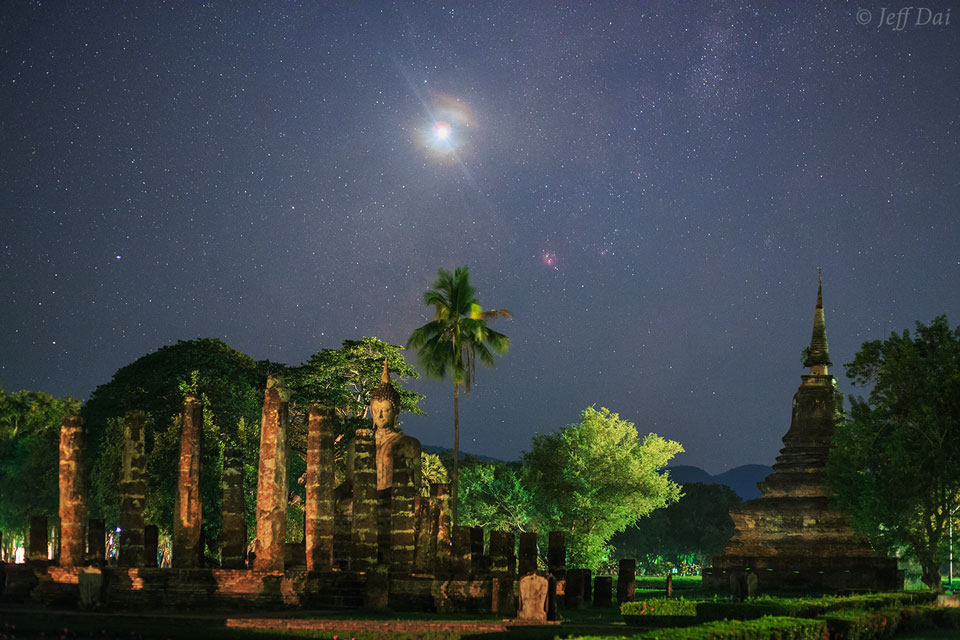 Nova over Thailand Image Credit & Copyright: Jeff Dai (TWAN) Explanation: A nova in Sagittarius is bright enough to see with binoculars. Detected last month, the stellar explosion even approached the limit of naked-eye visibility last week. A classical nova results from a thermonuclear explosion on the surface of a white dwarf star -- a dense star having the size of our Earth but the mass of our Sun. In the featured image, the nova was captured last week above ancient Wat Mahathat in Sukhothai, Thailand. To see Nova Sagittarius 2016 yourself, just go out just after sunset and locate near the western horizon the constellation of the Archer (Sagittarius), popularly identified with an iconic teapot. Also visible near the nova is the very bright planet Venus. Don’t delay, though, because not only is the nova fading, but that part of the sky is setting continually closer to sunset. Tomorrow's picture: ocean pluto ΠΗΓΗ: http://apod.nasa.gov/apod/astropix.html
__________________
VmF Skisters of Mercy © An eye for an eye, will make us all blind... Mahatma Ghandi |
| Οι παρακάτω χρήστες έχουν πει 'Ευχαριστώ' στον/στην pazo για αυτό το μήνυμα: | ||
Easty (23-11-16) | ||
 |
#3680
|
 |
|
||||
|
Astronomy Picture of the Day Discover the cosmos! Each day a different image or photograph of our fascinating universe is featured, along with a brief explanation written by a professional astronomer. 22 November 2016 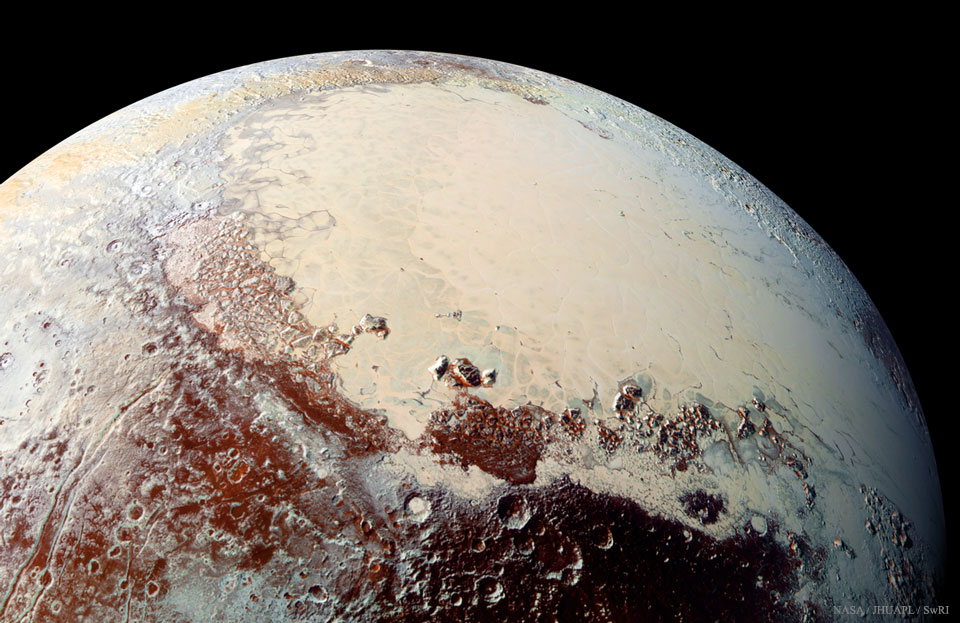 Pluto's Sputnik Planum Image Credit: NASA, Johns Hopkins U./APL, Southwest Research Inst. Explanation: Is there an ocean below Sputnik Planum on Pluto? The unusually smooth 1000-km wide golden expanse, visible in the featured image from New Horizons, appears segmented into convection cells. But how was this region created? One hypothesis now holds the answer to be a great impact that stirred up an underground ocean of salt water roughly 100-kilometers thick. The featured image of Sputnik Planum, part of the larger heart-shaped Tombaugh Regio, was taken last July and shows true details in exaggerated colors. Although the robotic New Horizons spacecraft is off on a new adventure, continued computer-modeling of this surprising surface feature on Pluto is likely to lead to more refined speculations about what lies beneath. Tomorrow's picture: big bubble ΠΗΓΗ: http://apod.nasa.gov/apod/astropix.html
__________________
VmF Skisters of Mercy © An eye for an eye, will make us all blind... Mahatma Ghandi |
| Οι παρακάτω χρήστες έχουν πει 'Ευχαριστώ' στον/στην pazo για αυτό το μήνυμα: | ||
Easty (23-11-16) | ||
 |
#3681
|
 |
|
||||
|
Astronomy Picture of the Day Discover the cosmos! Each day a different image or photograph of our fascinating universe is featured, along with a brief explanation written by a professional astronomer. 23 November 2016 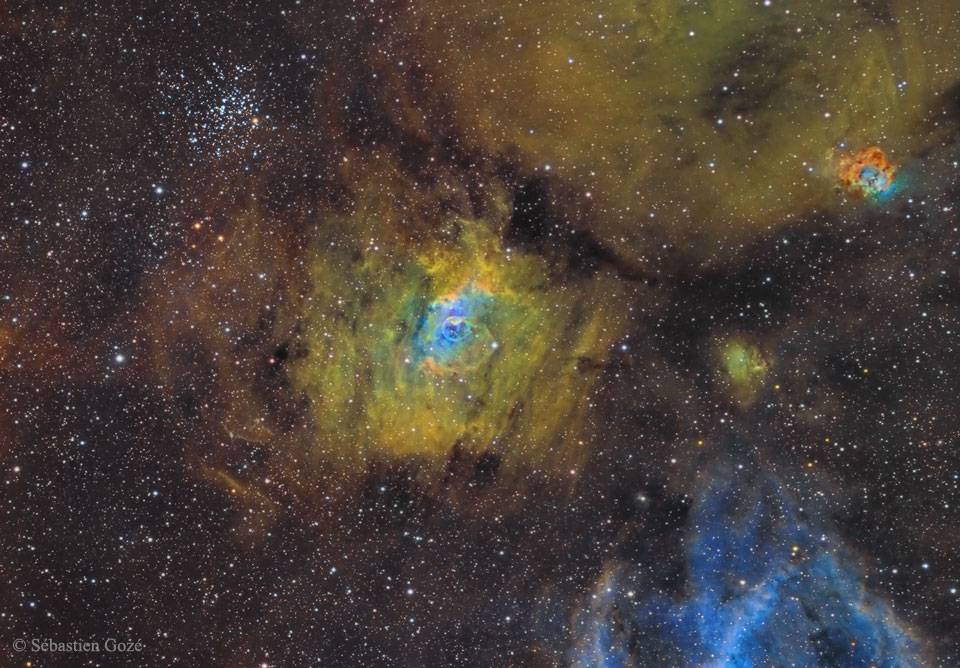 NGC 7635: Bubble in a Cosmic Sea Image Credit & Copyright: Sébastien Gozé Explanation: Do you see the bubble in the center? Seemingly adrift in a cosmic sea of stars and glowing gas, the delicate, floating apparition in this widefield view is cataloged as NGC 7635 - The Bubble Nebula. A mere 10 light-years wide, the tiny Bubble Nebula and the larger complex of interstellar gas and dust clouds are found about 11,000 light-years distant, straddling the boundary between the parental constellations Cepheus and Cassiopeia. Also included in the breathtaking vista is open star cluster M52 (upper left), some 5,000 light-years away. The featured image spans about two degrees on the sky corresponding to a width of about 375 light-years at the estimated distance of the Bubble Nebula. Tomorrow's picture: ring grazer ΠΗΓΗ: http://apod.nasa.gov/apod/astropix.html
__________________
VmF Skisters of Mercy © An eye for an eye, will make us all blind... Mahatma Ghandi |
| Οι παρακάτω χρήστες έχουν πει 'Ευχαριστώ' στον/στην pazo για αυτό το μήνυμα: | ||
Easty (23-11-16) | ||
 |
#3682
|
 |
|
||||
|
Astronomy Picture of the Day Discover the cosmos! Each day a different image or photograph of our fascinating universe is featured, along with a brief explanation written by a professional astronomer. 24 November 2016  Ring Scan Image Credit: Cassini Imaging Team, SSI, JPL, ESA, NASA Explanation: Scroll right and you can cruise along the icy rings of Saturn. This high resolution scan is a mosaic of images presented in natural color. The images were recorded in May 2007 over about 2.5 hours as the Cassini spacecraft passed above the unlit side of the rings. To help track your progress, major rings and gaps are labeled along with the distance from the center of the gas giant in kilometers. The alphabetical designation of Saturn's rings is historically based on their order of discovery; rings A and B are the bright rings separated by the Cassini division. In order of increasing distance from Saturn, the seven main rings run D,C,B,A,F,G,E. (Faint, outer rings G and E are not imaged here.) Four days from now, on November 29, Cassini will make a close flyby of Saturn's moon Titan and use the large moon's gravity to nudge the spacecraft into a series of 20 daring, elliptical, ring-grazing orbits. Diving through the ring plane just 11,000 kilometers outside the F ring (far right) Cassini's first ring-graze will be on December 4. Tomorrow's picture: where you parked ΠΗΓΗ: http://apod.nasa.gov/apod/astropix.html
__________________
VmF Skisters of Mercy © An eye for an eye, will make us all blind... Mahatma Ghandi |
 |
#3683
|
 |
|
||||
|
Astronomy Picture of the Day Discover the cosmos! Each day a different image or photograph of our fascinating universe is featured, along with a brief explanation written by a professional astronomer. 25 November 2016 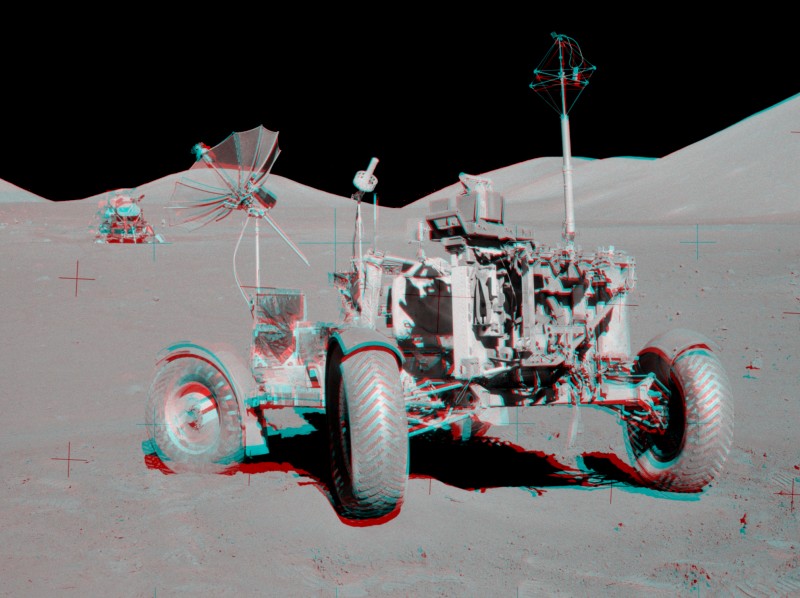 Apollo 17 VIP Site Anaglyph Image Credit: Gene Cernan, Apollo 17, NASA; Anaglyph by Erik van Meijgaarden Explanation: Get out your red/blue glasses and check out this stereo scene from Taurus-Littrow valley on the Moon! The color anaglyph features a detailed 3D view of Apollo 17's Lunar Rover in the foreground -- behind it lies the Lunar Module and distant lunar hills. Because the world was going to be able to watch the Lunar Module's ascent stage liftoff via the rover's TV camera, this parking place was also known as the VIP Site. In December of 1972, Apollo 17 astronauts Eugene Cernan and Harrison Schmitt spent about 75 hours on the Moon, while colleague Ronald Evans orbited overhead. The crew returned with 110 kilograms of rock and soil samples, more than from any of the other lunar landing sites. Cernan and Schmitt are still the last to walk (or drive) on the Moon. Tomorrow's picture: light-weekend ΠΗΓΗ: http://apod.nasa.gov/apod/astropix.html
__________________
VmF Skisters of Mercy © An eye for an eye, will make us all blind... Mahatma Ghandi |
 |
#3684
|
 |
|
||||
|
Astronomy Picture of the Day Discover the cosmos! Each day a different image or photograph of our fascinating universe is featured, along with a brief explanation written by a professional astronomer. 26 November 2016  East to West, Light and Shadow Image Credit & Copyright: Babak Tafreshi (TWAN) Explanation: On this November morning an old crescent Moon and morning star rise just before the Sun in a wide panoramic skyscape from Kenya's Amboseli National Park. Still below the limbs of an acacia tree and the eastern horizon, the Sun's position is easy to find though. It's marked at the left by the subtle convergence of light and shadow in the dawn sky. Known as crepuscular rays, the warm-colored rays of sunlight are outlined by shadows cast by unseen clouds near the horizon. Arcing above the profile of Mount Kilimanjaro, toward the right the rays of light and shadow converge at the western horizon. There known as anti-crepuscular rays, they indicate the point opposite the rising sun. The cloud shadows are very nearly parallel, but converge toward the distant horizons because of perspective. Tomorrow's picture: tallest known cliff ΠΗΓΗ: http://apod.nasa.gov/apod/astropix.html
__________________
VmF Skisters of Mercy © An eye for an eye, will make us all blind... Mahatma Ghandi |
 |
#3685
|
 |
|
||||
|
Astronomy Picture of the Day Discover the cosmos! Each day a different image or photograph of our fascinating universe is featured, along with a brief explanation written by a professional astronomer. 27 November 2016 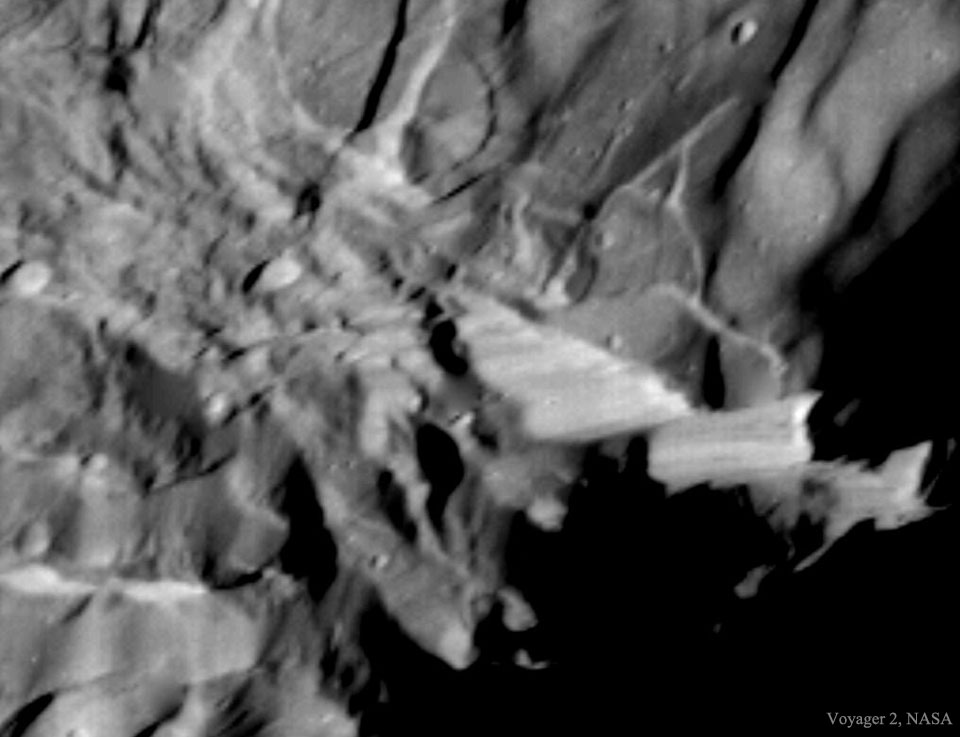 Verona Rupes: Tallest Known Cliff in the Solar System Image Credit: Voyager 2, NASA Explanation: Could you survive a jump off the tallest cliff in the Solar System? Quite possibly. Verona Rupes on Uranus' moon Miranda is estimated to be 20 kilometers deep -- ten times the depth of the Earth's Grand Canyon. Given Miranda's low gravity, it would take about 12 minutes for a thrill-seeking adventurer to fall from the top, reaching the bottom at the speed of a racecar -- about 200 kilometers per hour. Even so, the fall might be survivable given proper airbag protection. The featured image of Verona Rupes was captured by the passing Voyager 2 robotic spacecraft in 1986. How the giant cliff was created remains unknown, but is possibly related to a large impact or tectonic surface motion. Tomorrow's picture: galaxy bridge ΠΗΓΗ: http://apod.nasa.gov/apod/astropix.html
__________________
VmF Skisters of Mercy © An eye for an eye, will make us all blind... Mahatma Ghandi |
 |
#3686
|
 |
|
||||
|
Astronomy Picture of the Day Discover the cosmos! Each day a different image or photograph of our fascinating universe is featured, along with a brief explanation written by a professional astronomer. 28 November 2016 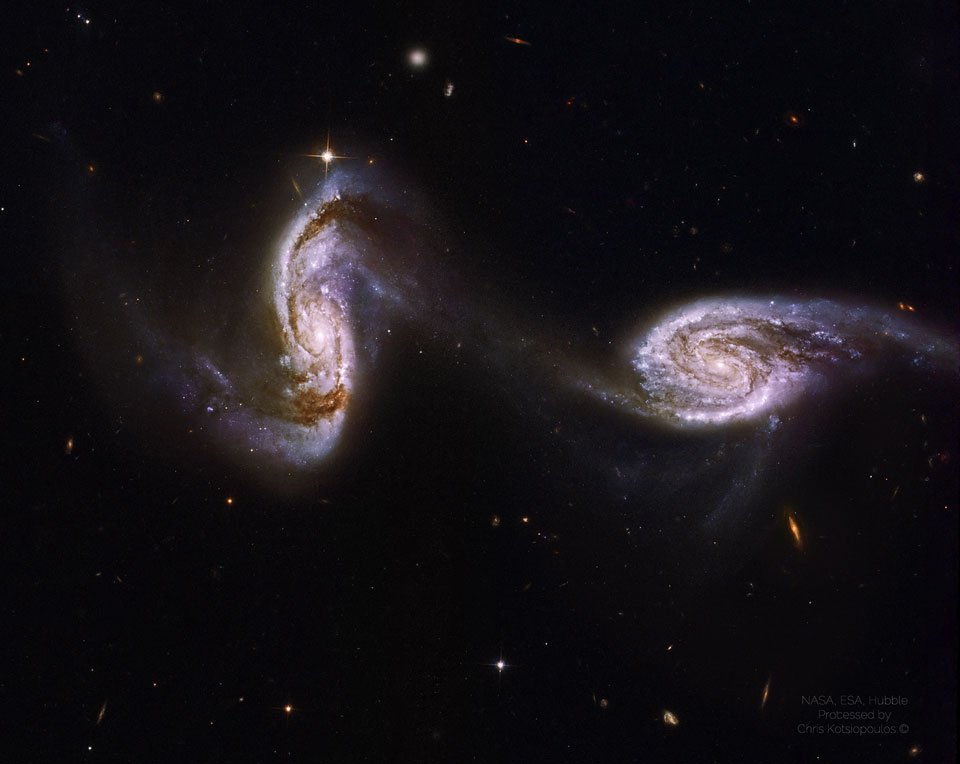 Arp 240: A Bridge between Spiral Galaxies from Hubble Image Credit: NASA, ESA, Hubble Space Telescope; Processing & Copyright: Chris Kotsiopoulos Explanation: Why is there a bridge between these two spiral galaxies? Made of gas and stars, the bridge provides strong evidence that these two immense star systems have passed close to each other and experienced violent tides induced by mutual gravity. Known together as Arp 240 but individually as NGC 5257 and NGC 5258, computer modelling and the ages of star clusters indicate that the two galaxies completed a first passage near each other only about 250 million years ago. Gravitational tides not only pulled away matter, they compress gas and so caused star formation in both galaxies and the unusual bridge. Galactic mergers are thought to be common, with Arp 240 representing a snapshot of a brief stage in this inevitable process. The Arp 240 pair are about 300 million light-years distant and can be seen with a small telescope toward the constellation of Virgo. Repeated close passages should ultimately result in a merger and with the emergence of a single combined galaxy. Tomorrow's picture: star bazaar ΠΗΓΗ: http://apod.nasa.gov/apod/astropix.html
__________________
VmF Skisters of Mercy © An eye for an eye, will make us all blind... Mahatma Ghandi |
| Οι παρακάτω χρήστες έχουν πει 'Ευχαριστώ' στον/στην pazo για αυτό το μήνυμα: | ||
Easty (30-11-16) | ||
 |
#3687
|
 |
|
||||
|
Astronomy Picture of the Day Discover the cosmos! Each day a different image or photograph of our fascinating universe is featured, along with a brief explanation written by a professional astronomer. 29 November 2016  W5: The Soul of Star Formation Image Credit: José Jiménez Priego (Astromet) Explanation: Where do stars form? Many times, stars form in energetic regions where gas and dark dust are pushed around in chaotic mayhem. Pictured, bright massive stars near the center of W5, the Soul Nebula, are exploding and emitting ionizing light and energetic winds. The outward-moving light and gas push away and evaporate much surrounding gas and dust, but leave pillars of gas behind dense protective knots. Inside these knots, though, stars also form. The featured image highlights the inner sanctum of W5, an arena spanning about 1,000 light years that is rich in star forming pillars. The Soul Nebula, also cataloged as IC 1848, lies about 6,500 light years away toward the constellation of the Queen of Aethopia (Cassiopeia). Likely, in few hundred million years, only a cluster of the resulting stars will remain. Then, these stars will drift apart. Tomorrow's picture: open space ΠΗΓΗ: http://apod.nasa.gov/apod/astropix.html
__________________
VmF Skisters of Mercy © An eye for an eye, will make us all blind... Mahatma Ghandi |
 |
#3688
|
 |
|
||||
|
Astronomy Picture of the Day Discover the cosmos! Each day a different image or photograph of our fascinating universe is featured, along with a brief explanation written by a professional astronomer. 30 November 2016  Milky Way over Shipwreck Image Credit & Copyright: Sergio Montúfar (Planetario Ciudad de La Plata) Explanation: What happened to this ship? It was carried aground by a giant storm that struck the coast of Argentina in 2002. The pictured abandoned boat, dubbed Naufragio del Chubasco, wrecked near the nearly abandoned town of Cabo Raso (population: 1). The rusting ship provides a picturesque but perhaps creepy foreground for the beautiful sky above. This sky is crowned by the grand arch of our Milky Way and features galaxies including the Large and Small Magellanic Clouds, stars including Canopus and Altair, planets including Mars and Neptune, and nebulas including the Lagoon, Carina, and the Coal Sack. The mosaic was composed from over 80 images taken in early September. A 360-degree interactive panoramic version of this image is also available. The adventurous astrophotographer reports that the creepiest part of taking this picture was not the abandoned ship, but the unusual prevalence of black and hairy caterpillars. Tomorrow's picture: pixels in space ΠΗΓΗ: http://apod.nasa.gov/apod/astropix.html
__________________
VmF Skisters of Mercy © An eye for an eye, will make us all blind... Mahatma Ghandi |
| Οι παρακάτω χρήστες έχουν πει 'Ευχαριστώ' στον/στην pazo για αυτό το μήνυμα: | ||
Easty (30-11-16) | ||
 |
#3689
|
 |
|
||||
|
Astronomy Picture of the Day Discover the cosmos! Each day a different image or photograph of our fascinating universe is featured, along with a brief explanation written by a professional astronomer. 1 December 2016  Flaming Star Nebula Image Credit & Copyright: Adam Block, Mt. Lemmon SkyCenter, Univ. Arizona Explanation: A runaway star lights the Flaming Star Nebula in this cosmic scene. Otherwise known as IC 405, the Flaming Star Nebula's billowing interstellar clouds of gas and dust lie about 1,500 light-years away toward the constellation of Auriga. AE Aurigae, the bright star at upper left in the frame, is a massive and intensely hot O-type star moving rapidly through space, likely ejected from a collision of multiple star-systems in the vicinity of the Orion Nebula millions of years ago. Now close to IC 405, the high-speed star's ionizing ultraviolet radiation powers the visible reddish glow as the nebula's hydrogen atoms are stripped of their electrons and recombine. Its intense blue starlight is reflected by the nebula's dusty filaments. Like all massive stars AE Aurigae will be short-lived though, furiously burning through its supply of fuel for nuclear fusion and exploding as a supernova. The colorful telescopic snapshot spans about 5 light-years at the estimated distance of the Flaming Star Nebula. Tomorrow's picture: a triple star is born ΠΗΓΗ: http://apod.nasa.gov/apod/astropix.html
__________________
VmF Skisters of Mercy © An eye for an eye, will make us all blind... Mahatma Ghandi |
 |
#3690
|
 |
|
||||
|
Astronomy Picture of the Day Discover the cosmos! Each day a different image or photograph of our fascinating universe is featured, along with a brief explanation written by a professional astronomer. 2 December 2016 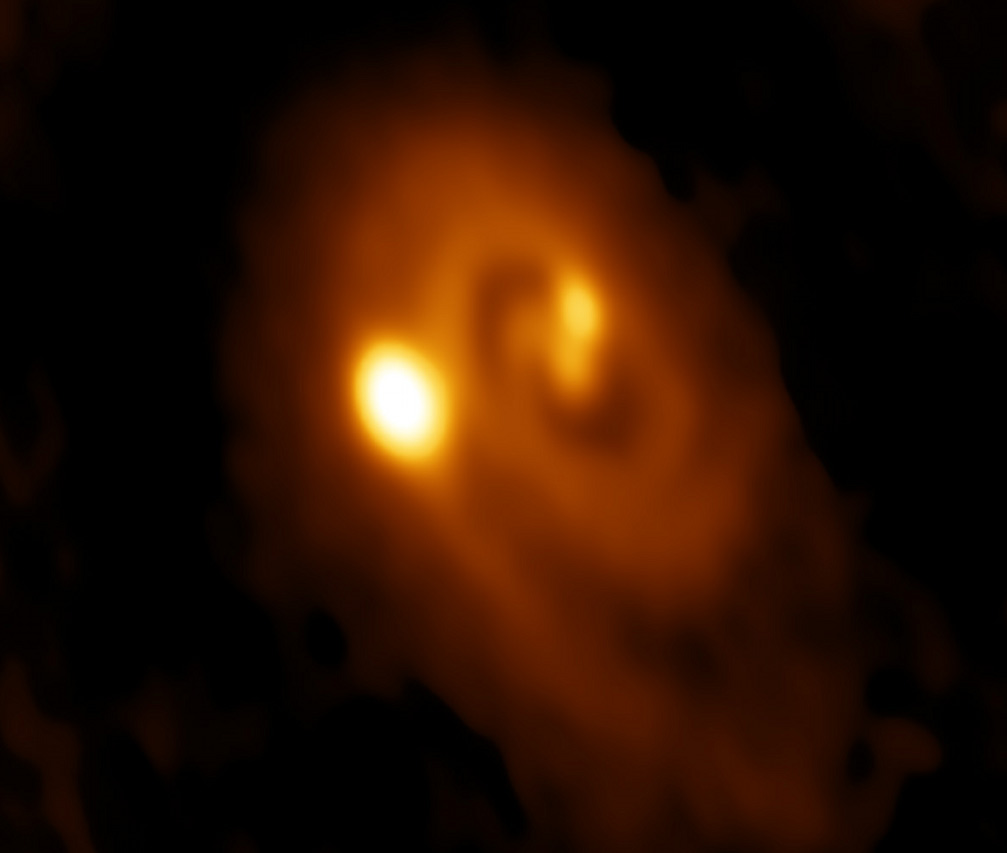 A Triple Star is Born IImage Credit: Bill Saxton, ALMA (ESO/NAOJ/NRAO), NRAO/AUI/NSF - Publication: John Tobin (Univ. Oklahoma/Leiden) et al. Explanation: A triple star system is forming, enshrouded within this dusty natal disk some 750 light-years away in the Perseus molecular cloud. Imaged at millimeter wavelengths by the Atacama Large Millimeter/submillimeter Array (ALMA) in Chile, the extreme close-up shows two protostars separated by a mere 61 AU (1 AU is the Earth-Sun distance) with a a third some 183 AU from the central protostar. The ALMA image also reveals a clear spiral structure indicating instability and fragmentation led to the multiple protostellar objects within the disk. Astronomers estimate that the system, cataloged as L1448 IRS3B, is less than 150,000 years old. Captured at an early phase, the starforming scenario is likely not at all uncommon, since almost half of all sun-like stars have at least one companion. Tomorrow's picture: beyond the stars ΠΗΓΗ: http://apod.nasa.gov/apod/astropix.html
__________________
VmF Skisters of Mercy © An eye for an eye, will make us all blind... Mahatma Ghandi |
 |
| Συνδεδεμένοι χρήστες που διαβάζουν αυτό το θέμα: 7 (0 μέλη και 7 επισκέπτες) | |
|
|